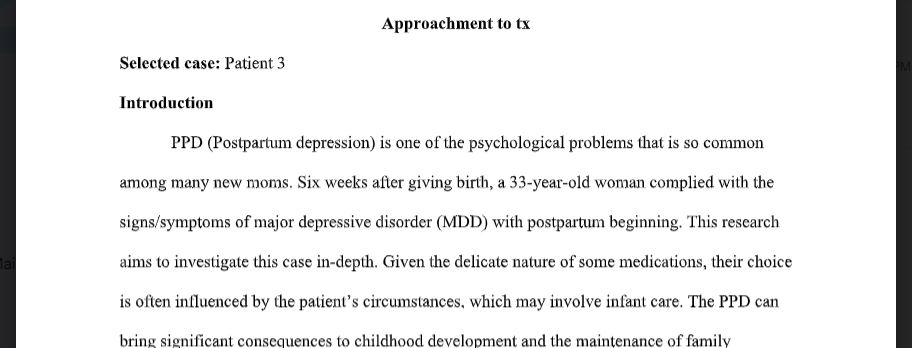Special Considerations For Patient Populations Paper
To complete this Assignment, you will choose a case study for a patient population for special consideration during prescribing practices. You will consider the specific patient and determine the appropriate medication to prescribe, based on the patient specifics and medication attributes in various case studies. You will construct a 4- to 5-page paper in which you determine the medication, the dosing, necessary patient education, and potential side effects. You will also indicate why the other medications would not be appropriate, as well as any necessary labs or diagnostics that might be needed. You will develop a plan to enhance medication adherence for the nonadherent patient. Special Considerations for Patient Population Cases:
Patient 1: 82-year-old male presenting with cognitive decline. He had always
been a very active individual. Over the past year, he has become less active
in the community. Previously, he played cribbage weekly with friends at the
local senior center but has been struggling with the math involved with the
game and no longer attends the weekly card game. He had also volunteered
as a crossing guard for the local public school. He quit doing that after he
took the wrong turn to get home and drove around the town feeling lost. He
acknowledges he is “sensitive” to this and can be irritable towards his children
when they bring up these concerns. He was diagnosed with mild
neurocognitive disorder after completing neuropsychological testing. Of the
following medications, which would be the most appropriate to prescribe?
Explain why you chose this medication. What would be the dosing schedule
for this patient? Provide education to the patient and review risks, benefits,
and potential side effects of the medication. In addition, explain why the other
medications listed are not appropriate for this patient. Med List: lorazepam,
olanzapine, memantine
Patient 2: 76-year-old female who recently moved from her home to an
assisted living. After 1 week of moving in, she has become extremely
confused. Staff have attempted to re-orient her, and she struggles to focus on
what they are saying. She is only oriented to self. She has become very
agitated and has even thrown breakable objects in her room. Her family is
concerned stating she is “out of it.” The PCP ordered labs and UA. Labs are
unremarkable outside of mild leukocytosis and positive dipstick analysis for
nitrite and red blood cells. Med List: valproate, alprazolam, trimethoprim
Patient 3: A 33-year-old female that is 6 weeks postpartum. She presents
with depressed mood, sadness, easily emotional, difficulties with sleep even
when the infant is sleeping. She has lost weight and has a poor appetite. You
note psychomotor retardation. She has limited interests in hobbies or bonding
with the infant. Her partner is concerned and reports she is typically active
and “bubbly” and enjoys the outdoors. She is diagnosed with major
depressive disorder, with postpartum onset. She denies suicidal ideation,
homicidal ideation, or infanticidal ideation. No psychotic symptoms are
present. She is nursing the infant and wants to continue this hoping it will
assist with bonding with the infant. Med List: lithium, paroxetine, sertraline
Patient 4: 10-year-old male who comes in with his father. He has been
diagnosed with generalized anxiety disorder. He has constant worries that he
cannot control. He feels nervous and tense. He is easily irritable. He struggles
to settle down or relax. He is also quite fidgety and restless. He and his father
are interested in medications to manage these symptoms. Med
List: quetiapine, duloxetine, fluoxetine
Patient 5: 27-year-old male with a diagnosis of schizophrenia. He has been
hospitalized three (3) times in the past 1 year due to symptoms. When
symptomatic, he becomes disorganized and paranoid. He will respond to
auditory hallucinations. He will scream out at night after seeing a shadow in
his room. He has delusions that the CIA is poisoning food and will not eat for
multiple days. He has unintentionally hurt his mother after “slapping” food out
of her hand, as he did not want her to ingest the “poisoned food.” Symptoms
are treated very well with paliperidone, but he struggles to remember to take
it. Med List: paliperidone palmitate, clozapine, lamotrigine
Construct a paper concerning your assigned vulnerable population patient case. In your
paper include the following:
Determine which medication would be most appropriate to prescribe from the
assigned vulnerable population patient case medication choices.
Explain your rationale for choosing this medication. Explain why the other
medications listed are not appropriate for this patient.
Explain the dosing schedule for the specific patient including the therapeutic
endpoint.
Provide necessary education to the patient to review risks, benefits, and
potential side effects of the medication.
Describe any necessary labs or additional diagnostics needed prior to
prescribing this medication.
Explain how you might monitor efficacy or side effects of the medication.
Include any additional collaboration or education to others that would be
necessary for this patient. Consider family members, home health care, primary
care providers, etc.
What would you need to include in your assessment for a patient who may
become nonadherent with your prescribing plan for your scenario? What are
alternative treatment solutions based upon how you assessed? Describe your
new treatment plan.
Answer preview for Special Considerations For Patient Populations Paper

APA
1220 Words
